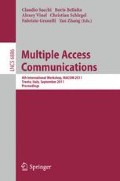Abstract
In a collaborative Cognitive Radio Network (CRN), Cognitive Radio (CR) nodes exchange information to perform the cognitive radio functions. The exchange of information in collaborative CRNs is usually based on a Cognitive Control Channel (CCC). CCC can be classified as in-band channel or out-band channel. An Out-band CCC channel is a CCC, which uses a specific spectrum band. In this paper, the authors propose the design of an out-band CCC based on an Ultra Wideband pulse shaped signal. The proposed design is particularly resilient to external harmful interference and it is able to adapt its spectrum occupation to the primary wireless services present in the area. We define the requirements for the CCC and we provide simulation results to validate the design of the CCC against such requirements.
Access this chapter
Tax calculation will be finalised at checkout
Purchases are for personal use only
Preview
Unable to display preview. Download preview PDF.
References
FCC ET Docket No. 03-108, Facilitating opportunities for flexible, efficient, and reliable spectrum use employing cognitive radio technologies, FCC Report and Order adopted (March 10, 2005)
Cordier, P., Houze, P., Jemaa, S.B., Simon, O., Bourse, D., Grandblaise, D., Moessner, K., Luo, J., Kloeck, C., Tsagkaris, K., Agusti, R., Olaziregi, N., Boufidis, Z., Buracchini, E., Goria, P., Trogolo, A.: E2r cognitive pilot channel concept. In: 15th IST Mobile and Wireless Communications Summit (2006)
Cabric, D., Mishra, S.M., Willkomm, D., Brodersen, R., Wolisz, A.: A cognitive radio approach for usage of virtual unlicensed spectrum. In: 14th IST Mobile and Wireless Communications Summit (2005)
Ganesan, G., Li, Y.: Agility improvement through cooperative diversity in cognitive radio. In: IEEE Global Telecommunications Conference, St. Louis, Missouri, USA, vol. 5, pp. 2505–2509 (November/December 2005)
Peng, C., Zheng, H., Zhao, B.Y.: Utilization and fairness in spectrum assignment for opportunistic spectrum access. In: ACM Mobile Networks and Applications, MONET (2006)
Han, C., Wang, J., Yang, Y., Li, S.: Addressing the control channel design problem: OFDM-based transform domain communication system in cognitive radio. Computer Networks, Cognitive Wireless Networks 52(4), 1286–1389 (2008)
Ma, L., Han, X., Shen, C.: Dynamic open spectrum sharing MAC protocol for wireless ad hoc network. In: DySPAN 2005, pp. 203–213 (November 2005)
Win, M.Z., Scholtz, R.A.: Ultra-wide bandwidth time-hopping spread-spectrum impulse radio for wireless multiple-access communications. IEEE Transactions Communications 48(4), 679–691 (2000)
Federal Communications Commission (FCC), Revision of Part 15 of the Commissions Rules Regarding Ultra-Wideband Transmission Systems. First Report and Order, ET Docket 98-153, FCC 02-48, pp. 1–118 (2002)
European Commission Decision 2007/131/EC, Allowing the Use of the Radio Spectrum for Equipment Using Ultra-Wideband Technology in a Harmonised Manner in the Community (June 2007)
Romme, J., Piazzo, L.: On the power spectral density of time-hopping impulse radio. In: IEEE Conference on Ultra-Wideband Systems and Technologies, Baltimore, MD, pp. 241–244 (2002)
Ye, Z., Madhukumar, A.S., Chin, F.: Power spectral density and in-band interference power of UWB signals at narrowband systems. In: IEEE International Conference on Communications (ICC 2004), Paris, vol. 6, pp. 3561–3565 (2004)
Di Benedetto, M.-G., De Nardis, L.: Tuning UWB signals by pulse shaping: towards context-aware wireless network. Eurasip Journal on Signal Processing, invited paper, Special Issue on Signal Processing in UWB Communications (2006)
Ameli, F., Piazzo, L.: Ultra-wide band spectrum shaping by means of a composite monocycle. Whyless.com Internal Report (2003)
Sheng, H., Orlik, P.V., Hiamovich, A., Cimini, L.J., Zhang, J.: On the spectral and power requirements for ultra-wideband transmission. In: Proceedings of the IEEE International Conference on Communications (ICC 2003), vol. 1, pp. 738–742 (2003)
Mcorkle, J.: Why such uproar over ultrawideband. Communications Design Magazine (2002)
Author information
Authors and Affiliations
Editor information
Editors and Affiliations
Rights and permissions
Copyright information
© 2011 Springer-Verlag Berlin Heidelberg
About this paper
Cite this paper
Baldini, G., Cano Pons, E. (2011). Design of a Robust Cognitive Control Channel for Cognitive Radio Networks Based on Ultra Wideband Pulse Shaped Signal. In: Sacchi, C., Bellalta, B., Vinel, A., Schlegel, C., Granelli, F., Zhang, Y. (eds) Multiple Access Communications. MACOM 2011. Lecture Notes in Computer Science, vol 6886. Springer, Berlin, Heidelberg. https://doi.org/10.1007/978-3-642-23795-9_2
Download citation
DOI: https://doi.org/10.1007/978-3-642-23795-9_2
Publisher Name: Springer, Berlin, Heidelberg
Print ISBN: 978-3-642-23794-2
Online ISBN: 978-3-642-23795-9
eBook Packages: Computer ScienceComputer Science (R0)

